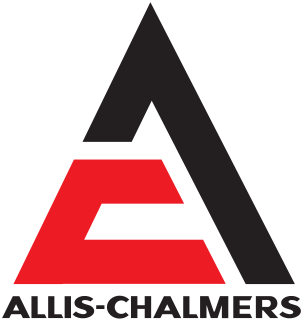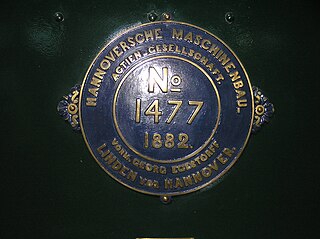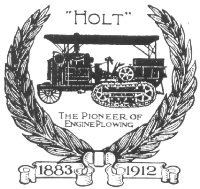Related Research Articles

Continuous track is a system of vehicle propulsion used in tracked vehicles, running on a continuous band of treads or track plates driven by two or more wheels. The large surface area of the tracks distributes the weight of the vehicle better than steel or rubber tyres on an equivalent vehicle, enabling continuous tracked vehicles to traverse soft ground with less likelihood of becoming stuck due to sinking.

A tractor is an engineering vehicle specifically designed to deliver a high tractive effort at slow speeds, for the purposes of hauling a trailer or machinery such as that used in agriculture, mining or construction. Most commonly, the term is used to describe a farm vehicle that provides the power and traction to mechanize agricultural tasks, especially tillage, and since many more. Agricultural implements may be towed behind or mounted on the tractor, and the tractor may also provide a source of power if the implement is mechanised.
The White Motor Company was an American automobile, truck, bus and agricultural tractor manufacturer from 1900 until 1980. The company also produced bicycles, roller skates, automatic lathes, and sewing machines. Before World War II, the company was based in Cleveland, Ohio. White Diesel Engine Division in Springfield, Ohio, manufactured diesel engine generators, which powered U.S. military equipment and infrastructure, namely Army Nike and Air Force Bomarc launch complexes, and other guided missile installations and proving grounds, sections of SAGE and DEW Line stations, radars, Combat Direction Centers and other ground facilities of the U.S. aerospace defense ring, such as the Texas Towers.

A traction engine is a steam-powered tractor used to move heavy loads on roads, plough ground or to provide power at a chosen location. The name derives from the Latin tractus, meaning 'drawn', since the prime function of any traction engine is to draw a load behind it. They are sometimes called road locomotives to distinguish them from railway locomotives – that is, steam engines that run on rails.

Orenstein & Koppel was a major German engineering company specialising in railway vehicles, escalators, and heavy equipment. It was founded on April 1, 1876 in Berlin by Benno Orenstein and Arthur Koppel.

A half-track is a civilian or military vehicle with regular wheels at the front for steering and continuous tracks at the back to propel the vehicle and carry most of the load. The purpose of this combination is to produce a vehicle with the cross-country capabilities of a tank and the handling of a wheeled vehicle.

Fordson was a brand name of tractors and trucks. It was used on a range of mass-produced general-purpose tractors manufactured by Henry Ford & Son Inc from 1917 to 1920, by Ford Motor Company (U.S.) and Ford Motor Company Ltd (U.K.) from 1920 to 1928, and by Ford Motor Company Ltd (U.K.) from 1929 to 1964. The latter also later built trucks and vans under the Fordson brand.

De Dion-Bouton was a French automobile manufacturer and railcar manufacturer operating from 1883 to 1953. The company was founded by the Marquis Jules-Albert de Dion, Georges Bouton, and Bouton's brother-in-law Charles Trépardoux.

Allis-Chalmers was a U.S. manufacturer of machinery for various industries. Its business lines included agricultural equipment, construction equipment, power generation and power transmission equipment, and machinery for use in industrial settings such as factories, flour mills, sawmills, textile mills, steel mills, refineries, mines, and ore mills.

A steam tractor is a vehicle powered by a steam engine which is used for pulling.

The Case Corporation was a manufacturer of agricultural machinery and construction equipment. Founded, in 1842, by Jerome Increase Case as the J. I. Case Threshing Machine Company, it operated under that name for most of a century. For another 66 years it was the J. I. Case Company, and was often called simply Case. In the late 19th century, Case was one of America's largest builders of steam engines, producing self-propelled portable engines, traction engines and steam tractors. It was a major producer of threshing machines and other harvesting equipment. The company also produced various machinery for the U.S. military. In the 20th century, Case was among the ten largest builders of farm tractors for many years. In the 1950s its construction equipment line became its primary focus, with agricultural business second.

Richard Hornsby & Sons was an engine and machinery manufacturer in Grantham, Lincolnshire, England from 1828 until 1918. The company was a pioneer in the manufacture of the oil engine developed by Herbert Akroyd Stuart, which was marketed under the Hornsby-Akroyd name. The company developed an early track system for vehicles, selling the patent to Holt & Co. in America. In 1918, Richard Hornsby & Sons became a subsidiary of the neighbouring engineering firm Rustons of Lincoln, to create Ruston & Hornsby.

Hanomag was a German producer of steam locomotives, tractors, trucks and military vehicles in Hanover. Hanomag first achieved international fame by delivering numerous steam locomotives to Finland, Romania and Bulgaria before World War I and making of first tractor Hanomag R26 in 1924 in Germany. In 1925, they added automobiles to their line, additionally moving in 1931 into the production of construction machinery. Since 1989, the company has been part of the Komatsu company.

The Avery Company, founded by Robert Hanneman Avery, was an American farm tractor manufacturer famed for its undermounted engine which resembled a railroad engine more than a conventional farm steam engine. Avery founded the farm implement business after the Civil War. His company built a large line of products, including steam engines, beginning in 1891. The company started with a return flue design and later adapted the undermount style, including a bulldog design on the smokebox door. Their design was well received by farmers in central Illinois. They expanded their market nationwide and overseas until the 1920s, when they failed to innovate and the company faltered. They manufactured trucks for a period of time, and then automobiles. until they finally succumbed to an agricultural crisis and the Depression.

The history of steam road vehicles comprises the development of vehicles powered by a steam engine for use on land and independent of rails, whether for conventional road use, such as the steam car and steam waggon, or for agricultural or heavy haulage work, such as the traction engine.

Clayton & Shuttleworth was an engineering company located at Stamp End Works, Lincoln, Lincolnshire, England. The company was established in 1842 when Nathaniel Clayton (1811–1890) formed a partnership with his brother-in-law, Joseph Shuttleworth (1819–83).

The Holt Manufacturing Company began with the 1883 founding of Stockton Wheel Service in Stockton, California, United States. Benjamin Holt, later credited with patenting the first workable crawler ("caterpillar") tractor design, incorporated the Holt Manufacturing Company in 1892. Holt Manufacturing Company was the first company to successfully manufacture a continuous track tractor By the early 20th century, Holt Manufacturing Company was the leading manufacturer of combine harvesters in the US, and the leading California-based manufacturer of steam traction engines.

The RÁBA Automotive Group, commonly known as Rába, is a Hungarian public limited company, listed on the Budapest Stock Exchange. Rába engineers, manufactures and customizes automotive components, specialty vehicles and axles for commercial vehicles, agri-machinery and earth-movers. The Rába has been building axles as well as complete vehicles since 1902. The company has three strategic business units. The company is headquartered in Győr, employing more than 2000 people.

The Nottingham Industrial Museum is a volunteer-run museum situated in part of the 17th-century stables block of Wollaton Hall, located in a suburb of the city of Nottingham. The museum won the Nottinghamshire Heritage Site of the Year Award 2012, a local accolade issued by Experience Nottinghamshire. The Museum collection closed in 2009 after Nottingham City Council withdrew funding, but has since reopened at weekends and bank holidays, helped by a £91,000 government grant, and run by volunteers. The museum contains a display of local textiles machinery, transport, telecommunications, mining and engineering technology. There is a display of cycles, motorcycles, and motor cars. There are examples of significant lace-making machinery. It also houses an operational beam engine, from the Basford, Nottingham pumping station.